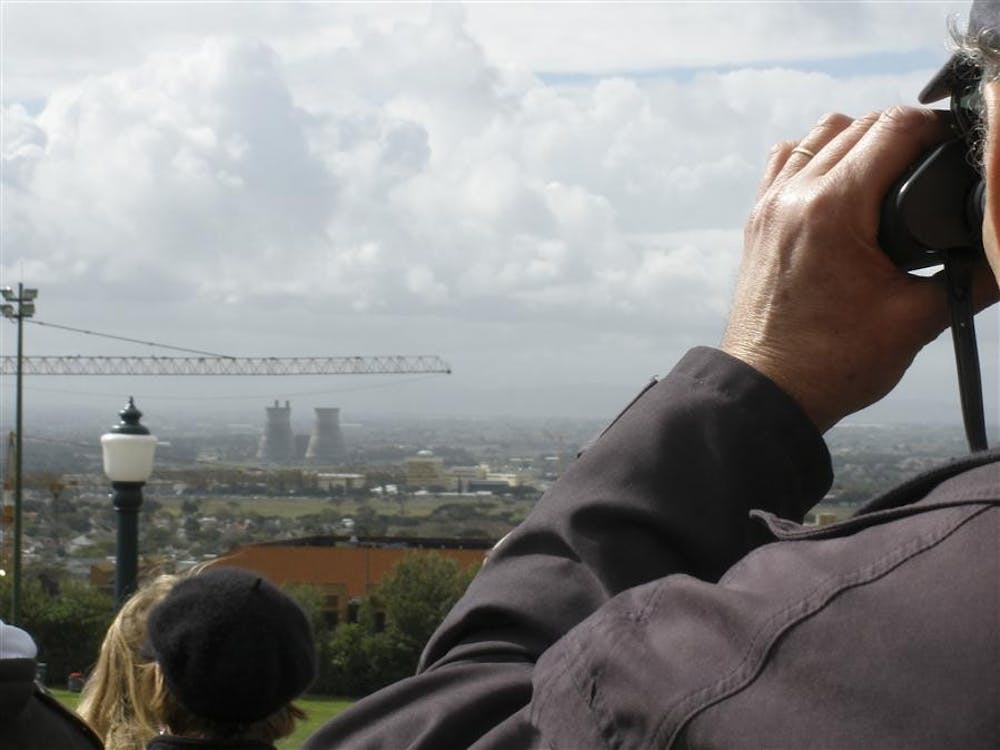CAPE TOWN, SOUTH AFRICA – The Athlone Towers came tumbling down at 11:56 a.m. Sunday. They vanished in eight seconds.
The iconic pair of 283-foot-tall power plant cooling towers, located centrally amid Cape Town’s sprawling southern suburbs, twisted like concrete Slinkies as choreographed blasts raced around their midsection.
Families flocked by the thousands to high points in the city, jostling for positions to witness and record the bittersweet demolition. The implosion was as visible a sign of progress and government action as the 2010 World Cup, but it was also a solemn, nostalgic occasion, not unlike saying goodbye to old friends.
The hollow, flask-shaped towers had literally been crumbling for years and were eyesores in a skyline dominated by crisp mountain peaks. The coal power plant they serviced was decommissioned in 2006 after almost 50 years of operation.
The site remained lifeless until Sunday’s blast, but the towers weren’t totally abandoned. A pair of falcons lived on the upper rim of one of the stacks since 1989.
As part of the contract to demolish the towers, the city went to great lengths — and heights — to accommodate the avian couple. Peregrine falcons breed for life. They choose a partner and a breeding site and stick with them for their full 15 to 20 year lifespan.
The descriptor “peregrine” means “having a tendency to wander.” While the birds do fly thousands of miles every year, diving at speeds of up to 200 miles per hour to snatch a meaty meal along the coast, their strong homing instinct unfailingly leads them
back home.
They don’t build nests. Instead, they lay eggs in sand on cliff ledges or in the city, the next best alternative to a cliff ledge. When the birds first began frequenting the Athlone cooling towers in the 1980s, ornithologists from the University of Cape Town placed three large boxes — each filled with a base layer of sand to mimic the falcons’ requisite breeding habitat — atop one of the towers.
Year after year, for two decades, this pair of Peregrine falcons returned to the top of the towers — the tallest man-made structures outside the downtown area — to breed and raise chicks. To ensure the falcons could continue to breed at the site post-demolition, the city allowed researchers to move the breeding boxes to a nearby brick chimney of the power station. The relocation was a gradual process.
Time will tell whether the aging falcons of Athlone fully adapt to their new perch. So far, researchers say, the outlook is positive, and the birds will soon breed again. The city committed an entire website and a portion of its demolition contract to the story of the birds.
It’s a fascinating sub-story in the broader context of South Africa’s post-Apartheid poverty trap. Birds are getting home relocation and a mention in city contracts. Meanwhile, the miles of slums around the base of the Athlone towers get covered in blast dust.
In many ways the towers were like the slums: too big to miss, so familiar they blended into the morning commute, ugly scars of the past and in desperate need of visible, decisive government action.
The towers got theirs, and the city got its message out: The falcons of Athlone are safe and right at home.
Editor’s Note: At least 2,000 IU-Bloomington students study abroad in 50 countries every year. The Writers Abroad program, now in its fourth semester at the Indiana Daily Student, brings some of those students’ stories back to Bloomington. We will not have a nation & world page this semester, but we’re keeping Writers Abroad. You can find the columns on the campus page. They might not be there every day, but check online for columns you might miss. We have 15 students from around the world who will take you into their lives and give you a glimpse into their world.
The Falcons of Athlone

Get stories like this in your inbox
Subscribe





